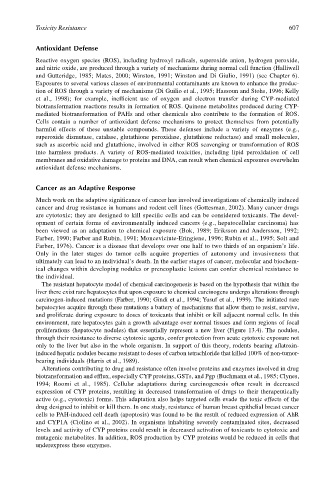Page 627 - The Toxicology of Fishes
P. 627
Toxicity Resistance 607
Antioxidant Defense
Reactive oxygen species (ROS), including hydroxyl radicals, superoxide anion, hydrogen peroxide,
and nitric oxide, are produced through a variety of mechanisms during normal cell function (Halliwell
and Gutteridge, 1985; Mates, 2000; Winston, 1991; Winston and Di Giulio, 1991) (see Chapter 6).
Exposures to several various classes of environmental contaminants are known to enhance the produc-
tion of ROS through a variety of mechanisms (Di Guilio et al., 1995; Hassoun and Stohs, 1996; Kelly
et al., 1998); for example, inefficient use of oxygen and electron transfer during CYP-mediated
biotransformation reactions results in formation of ROS. Quinone metabolites produced during CYP-
mediated biotransformation of PAHs and other chemicals also contribute to the formation of ROS.
Cells contain a number of antioxidant defense mechanisms to protect themselves from potentially
harmful effects of these unstable compounds. These defenses include a variety of enzymes (e.g.,
superoxide dismutase, catalase, glutathione peroxidase, glutathione reductase) and small molecules,
such as ascorbic acid and glutathione, involved in either ROS scavenging or transformation of ROS
into harmless products. A variety of ROS-mediated toxicities, including lipid peroxidation of cell
membranes and oxidative damage to proteins and DNA, can result when chemical exposures overwhelm
antioxidant defense mechanisms.
Cancer as an Adaptive Response
Much work on the adaptive significance of cancer has involved investigations of chemically induced
cancer and drug resistance in humans and rodent cell lines (Gottesman, 2002). Many cancer drugs
are cytotoxic; they are designed to kill specific cells and can be considered toxicants. The devel-
opment of certain forms of environmentally induced cancers (e.g., hepatocellular carcinoma) has
been viewed as an adaptation to chemical exposure (Bok, 1989; Eriksson and Andersson, 1992;
Farber, 1990; Farber and Rubin, 1991; Monceviciute-Eringiene, 1996; Rubin et al., 1995; Solt and
Farber, 1976). Cancer is a disease that develops over one half to two thirds of an organism’s life.
Only in the later stages do tumor cells acquire properties of autonomy and invasiveness that
ultimately can lead to an individual’s death. In the earlier stages of cancer, molecular and biochem-
ical changes within developing nodules or preneoplastic lesions can confer chemical resistance to
the individual.
The resistant hepatocyte model of chemical carcinogenesis is based on the hypothesis that within the
liver there exist rare hepatocytes that upon exposure to chemical carcinogens undergo alterations through
carcinogen-induced mutations (Farber, 1990; Gindi et al., 1994; Yusuf et al., 1999). The initiated rare
hepatocytes acquire through these mutations a battery of mechanisms that allow them to resist, survive,
and proliferate during exposure to doses of toxicants that inhibit or kill adjacent normal cells. In this
environment, rare hepatocytes gain a growth advantage over normal tissues and form regions of focal
proliferations (hepatocyte nodules) that essentially represent a new liver (Figure 13.4). The nodules,
through their resistance to diverse cytotoxic agents, confer protection from acute cytotoxic exposure not
only to the liver but also in the whole organism. In support of this theory, rodents bearing aflatoxin-
induced hepatic nodules became resistant to doses of carbon tetrachloride that killed 100% of non-tumor-
bearing individuals (Harris et al., 1989).
Alterations contributing to drug and resistance often involve proteins and enzymes involved in drug
biotransformation and efflux, especially CYP proteins, GSTs, and Pgp (Buchmann et al., 1985; Clynes,
1994; Roomi et al., 1985). Cellular adaptations during carcinogenesis often result in decreased
expression of CYP proteins, resulting in decreased transformation of drugs to their therapeutically
active (e.g., cytotoxic) forms. This adaptation also helps targeted cells evade the toxic effects of the
drug designed to inhibit or kill them. In one study, resistance of human breast epithelial breast cancer
cells to PAH-induced cell death (apoptosis) was found to be the result of reduced expression of AhR
and CYP1A (Ciolino et al., 2002). In organisms inhabiting severely contaminated sites, decreased
levels and activity of CYP proteins could result in decreased activation of toxicants to cytotoxic and
mutagenic metabolites. In addition, ROS production by CYP proteins would be reduced in cells that
underexpress these enzymes.

